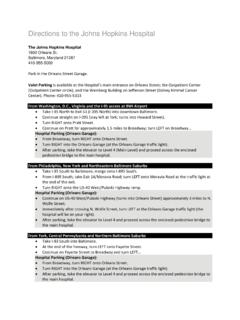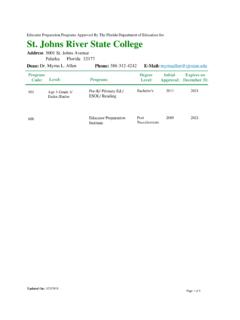Transcription of equalization - University of Toronto
1 Slide 1 of 70 University of Toronto Johns, 1997 EqualizationProf. David JohnsUniversity of 2 of 70 University of Toronto Johns, 1997 Adaptive Filter Introduction Adaptive filters are used in: Noise cancellation Echo cancellation Sinusoidal enhancement (or rejection) Beamforming equalization Adaptive equalization for data communications proposed by Lucky at Bell Labs in 1965. LMS algorithm developed by Widrow and Hoff in 60s for neural network adaptationslide 3 of 70 University of Toronto Johns, 1997 Adaptive Filter Introduction A typical adaptive system consists of the following two-input, two output system and are the filter s input and output and are the reference and error signalsyn() n()un()Hz()en()adaptivealgorithmyn()+-un ()yn() n()en()slide 4 of 70 University of Toronto Johns, 1997 Adaptive Filter Goal Find a set of filter coefficients to minimize the power of the error signal.
2 Normally assume the time-constant of the adaptive algorithm is much slower than those of the filter, . If it were instantaneous, it could always set equal to and the error would be zero (this is useless) Think of adaptive algorithm as an optimizer which finds the best set of fixed filter coefficients that minimizes the power of the error ()Hz()yn() n()slide 5 of 70 University of Toronto Johns, 1997 Noise (and Echo) Cancellation Useful in cockpit noise cancelling, fetal heart monitoring, acoustic noise cancelling, echo cancelling, ()H1z( )noise = n()un()Hz()en()signal=+-H1z()H2z()++H1z( )noise noisesignalHz()H1z()H2z() =slide 6 of 70 University of Toronto Johns, 1997 Sinusoidal Enhancement (or Rejection)
3 The sinusoid s frequency and amplitude are unknown. If is adjusted such that its phase plus the delay equals 360 degrees at the sinusoid s frequency, the sinusoid is cancelled while the noise is passed. The noise might be a broadband signal which should be ()Hz()+- sinusoidnoise+sinusoidnoise n()yn()en()fixed delayHz()slide 7 of 70 University of Toronto Johns, 1997 Adaptation Algorithm Optimization might be performed by: perturb some coefficient in and check whether the power of the error signal increased or decreased. If it decreased, go on to the next coefficient. If it increased, switch the sign of the coefficient change and go on to the next coefficient.
4 Repeat this procedure until the error signal is minimized. This approach is a steepest-descent algorithm but is slow and not very accurate. The LMS (Least-Mean-Square) algorithm is also a steepest-descent algorithm but is more accurate and simpler to realizeHz()slide 8 of 70 University of Toronto Johns, 1997 Steepest-Descent Algorithm Minimize the power of the error signal, General steepest-descent for filter coefficient : Here and controls the adaptation rateEe2n()[]pin()pin1+()pin() Ee2n()[] pi ----------------------- = 0>slide 9 of 70 University of Toronto Johns, 1997 Steepest Descent Algorithm In the one-dimensional caseEe2n()[]pipi*pi0()pi1()pi2()Ee2n()[] pi -----------------------0>slide 10 of 70 University of Toronto Johns, 1997 Steepest-Descent Algorithm In the two-dimensional case Steepest-descent path follows perpendicular to tangents of the contour ()[]p1p2(out of page)p1*p2*slide 11 of 70 University of Toronto Johns, 1997 LMS Algorithm Replace expected error squared with instantaneous error squared.
5 Let adaptation time smooth out result. and since , we have and are uncorrelated after +()pin() e2n() pi -------------- =pin1+()pin() 2 en()en() pi ------------ =en() n()yn() =pin1+()pin() 2 en() in() where iyn() pi =+=en() in()slide 12 of 70 University of Toronto Johns, 1997 Variants of the LMS Algorithm To reduce implementation complexity, variants are taking the sign of and/or . LMS Sign-data LMS Sign-error LMS Sign-sign LMS However, the sign-data and sign-sign algorithms have gradient misadjustment may not converge! These LMS algorithms have different dc offset implications in analog () in()pin1+()pin() 2 en() in() +=pin1+()pin() 2 en() in()()sgn +=pin1+()pin() 2 en()()sgn in() +=in1+()pin() 2 en()()sgn in()(sgn +=slide 13 of 70 University of Toronto Johns, 1997 Obtaining Gradient Signals is a LTI system where the signal-flow-graph arm corresponding to coefficient is shown explicitly.)
6 Is the impulse response of from to The gradient signal with respect to element is the convolution of with convolved with .piHz()yn()un()humn()mnhnyn() in()yn() pi ------------hnyn()humn()un() ==Hz()pihumn()umpiun()humn()hnyn()slide 14 of 70 University of Toronto Johns, 1997 Gradient Example-1G1G2G3yt()ut()-1G1G2G3vlpt()vbp t()vlpt()yt() G2 -----------v lpt()=yt() G3 -----------v bpt()=yt() G1 -----------111slide 15 of 70 University of Toronto Johns, 1997 Adaptive Linear Combineryn()pin()xin() =un()p1n()p2n()pNn()+- n()en()x1n()x2n()xNn()yn()Hz()Yz()Uz()-- --------=Nstategeneratoroften, a tapped delay lineyn() pi ------------xin()
7 =slide 16 of 70 University of Toronto Johns, 1997 Adaptive Linear Combiner The gradient signals are simply the state signals(1) Only the zeros of the filter are being adjusted. There is no need to check that for filter stability (though the adaptive algorithm could go unstable if is too large). The performance surface is guaranteed unimodal ( there is only one minimum so no need to worry about being stuck in a local minimum). The performance surface becomes ill-conditioned as the state-signals become correlated (or have large power variations).pin1+()pin() 2 en()xin()+= slide 17 of 70 University of Toronto Johns, 1997 Performance Surface Correlation of two states is determined by multiplying the two signals together and averaging the output.
8 Uncorrelated (and equal power) states result in a hyper-paraboloid performance surface good adaptation rate. Highly-correlated states imply an ill-conditioned performance surface more residual mean-square error and longer adaptation ()[]p1(out of page)p1*p2*slide 18 of 70 University of Toronto Johns, 1997 Adaptation Rate Quantify performance surface state-correlation matrix Eigenvalues, , of are all positive real indicate curvature along the principle axes. For adaptation stability, but adaptation rate is determined by least steepest curvature, . Eigenvalue spread indicates performance surface []Ex1x2[]Ex1x3[]Ex2x1[]Ex2x2[]Ex2x3[]Ex3 x1[]Ex3x2[]Ex3x3[] iR0 1 max----------<< minslide 19 of 70 University of Toronto Johns, 1997 Adaptation Rate Adaptation rate might be 100 to 1000 times slower than time-constants in programmable filter.
9 Typically use same for all coefficient parameters since orientation of performance surface not usually known. A large value of results in a larger coefficient bounce . A small value of results in slow adaptation Often gear-shift use a large value at start-up then switch to a smaller value during steady-state. Might need to detect if one should gear-shift again. slide 20 of 70 University of Toronto Johns, 1997 Adaptive IIR Filtering The poles (and often the zeros) are adjusted useful in applications with long impulse responses. Stability check needed for the adaptive filter itself to ensure the poles do not go outside the unit circle for too long a time (or perhaps at all).
10 In general, a multi-modal performance surface occurs. Can get stuck in local minimum. However, if the order of the adaptive filter is greater than the order of the system being matched (and all poles and zeros are being adapted) the performance surface is unimodal. To obtain the gradient signals for poles, extra filters are generally 21 of 70 University of Toronto Johns, 1997 Adaptive IIR Filtering Direct-form structure needs only one additional filter to obtain all the gradient signals. However, choice of structure for programmable filter is VERY important sensitive structures tend to have ill-conditioned performance surfaces.













